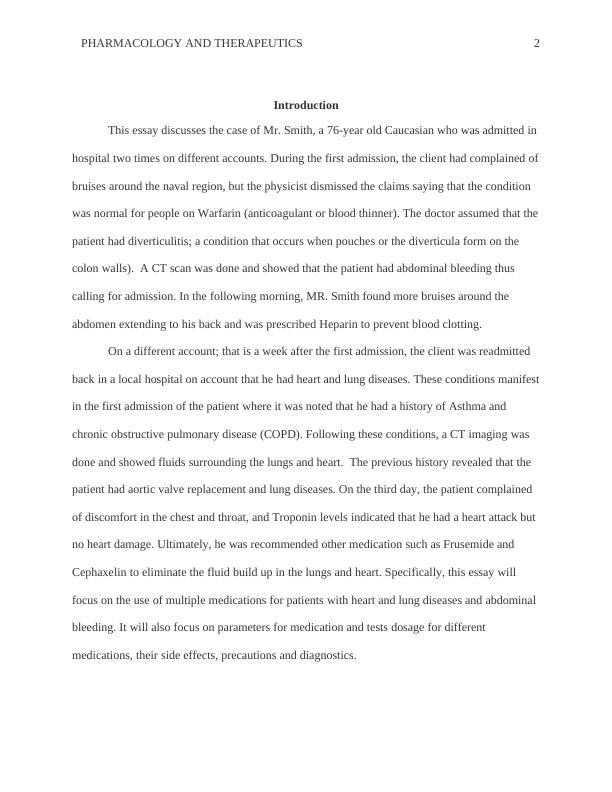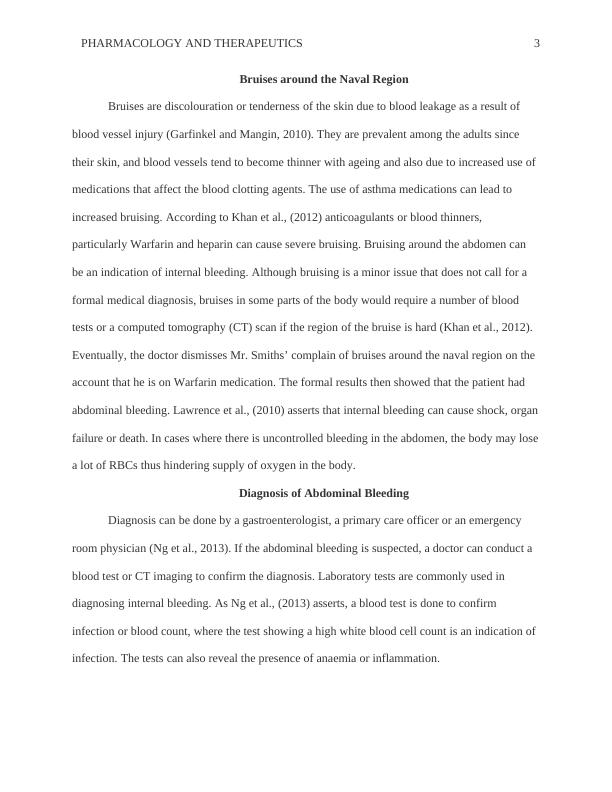Essay on Pharmacology and Therapeutics Case
Added on 2019-11-29
13 Pages3790 Words276 Views
Running head: PHARMACOLOGY AND THERAPEUTICS 1Pharmacology and TherapeuticsStudent’s NameUniversity Affiliation

PHARMACOLOGY AND THERAPEUTICS 2IntroductionThis essay discusses the case of Mr. Smith, a 76-year old Caucasian who was admitted in hospital two times on different accounts. During the first admission, the client had complained ofbruises around the naval region, but the physicist dismissed the claims saying that the condition was normal for people on Warfarin (anticoagulant or blood thinner). The doctor assumed that thepatient had diverticulitis; a condition that occurs when pouches or the diverticula form on the colon walls). A CT scan was done and showed that the patient had abdominal bleeding thus calling for admission. In the following morning, MR. Smith found more bruises around the abdomen extending to his back and was prescribed Heparin to prevent blood clotting.On a different account; that is a week after the first admission, the client was readmitted back in a local hospital on account that he had heart and lung diseases. These conditions manifestin the first admission of the patient where it was noted that he had a history of Asthma and chronic obstructive pulmonary disease (COPD). Following these conditions, a CT imaging was done and showed fluids surrounding the lungs and heart. The previous history revealed that the patient had aortic valve replacement and lung diseases. On the third day, the patient complained of discomfort in the chest and throat, and Troponin levels indicated that he had a heart attack but no heart damage. Ultimately, he was recommended other medication such as Frusemide and Cephaxelin to eliminate the fluid build up in the lungs and heart. Specifically, this essay will focus on the use of multiple medications for patients with heart and lung diseases and abdominal bleeding. It will also focus on parameters for medication and tests dosage for different medications, their side effects, precautions and diagnostics.

PHARMACOLOGY AND THERAPEUTICS 3Bruises around the Naval RegionBruises are discolouration or tenderness of the skin due to blood leakage as a result of blood vessel injury (Garfinkel and Mangin, 2010). They are prevalent among the adults since their skin, and blood vessels tend to become thinner with ageing and also due to increased use of medications that affect the blood clotting agents. The use of asthma medications can lead to increased bruising. According to Khan et al., (2012) anticoagulants or blood thinners, particularly Warfarin and heparin can cause severe bruising. Bruising around the abdomen can be an indication of internal bleeding. Although bruising is a minor issue that does not call for a formal medical diagnosis, bruises in some parts of the body would require a number of blood tests or a computed tomography (CT) scan if the region of the bruise is hard (Khan et al., 2012). Eventually, the doctor dismisses Mr. Smiths’ complain of bruises around the naval region on the account that he is on Warfarin medication. The formal results then showed that the patient had abdominal bleeding. Lawrence et al., (2010) asserts that internal bleeding can cause shock, organfailure or death. In cases where there is uncontrolled bleeding in the abdomen, the body may losea lot of RBCs thus hindering supply of oxygen in the body. Diagnosis of Abdominal BleedingDiagnosis can be done by a gastroenterologist, a primary care officer or an emergency room physician (Ng et al., 2013). If the abdominal bleeding is suspected, a doctor can conduct a blood test or CT imaging to confirm the diagnosis. Laboratory tests are commonly used in diagnosing internal bleeding. As Ng et al., (2013) asserts, a blood test is done to confirm infection or blood count, where the test showing a high white blood cell count is an indication of infection. The tests can also reveal the presence of anaemia or inflammation.

PHARMACOLOGY AND THERAPEUTICS 4A CT scan is another commonly used method to diagnose abdominal bleeding. According to the World Gastroenterology Organisation (WGO), the tomography scan offers benefits of evaluating bowel and mesentery with a sensitivity of 67% to 97% and specificity of 76% to 100%. Computed tomography findings show bowel wall thickening, periodic fat stranding, free fluid and an abscess (Robertson et al., 2014). Moreover, an inflamed pouch can show overhead sign where an iodinated contrast represents an overhead configuration at the foot of the inflamed pouch. The primary reason why the scan will show a thick bowel wall is that when inflammation occurs, free air, as well as abscess formation will be present. However, correct diagnosis of the bleeding ranges from 60 to 97% as per the facility evaluated. As of late, a vast number of physicians order a CT scan over Barium enema, which is usually ordered when the diagnosis from the CT scan is not conclusive (Walker and Harris et al., 2017). After performing an abdominal CT scan from the patient, the result showed that Mr. Smith had an internal bleeding and needed to be admitted. Earlier on, the doctor had suspected diverticulosis and prescribed three medications; Amoxicillin 500mg, Movical to help with constipation, and Endone 2.5 mg to relieve pain.Medications for internal bleeding1. AmoxicillinThis is an antibiotic used to treat bacterial infections. Doctors prescribe amoxicillin to treat different infections such as urinary tract infection, lungs, stomach and skin infections. It is important to finish a prescribed medication even if a person feels better in the course of taking the drug. Although amoxicillin could interfere with some birth control pills for the women, elderly adults like the case of Mr. Smith needs to take a lower dosage of the drug. Also using the

End of preview
Want to access all the pages? Upload your documents or become a member.
Related Documents
Pharmacokinetic Comparison of Warfarin and Heparinlg...
|27
|5009
|66
Coronary Artery Case Study Assignment 2022lg...
|14
|3537
|6
Case Study on Evaluation of Paperslg...
|5
|823
|38
MHS1102: Anatomy and Physiology | Case Studylg...
|5
|1441
|734
